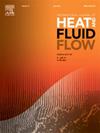具有不同进出口排列的芯片散热器的伪三维拓扑优化
IF 2.6
3区 工程技术
Q2 ENGINEERING, MECHANICAL
International Journal of Heat and Fluid Flow
Pub Date : 2024-11-26
DOI:10.1016/j.ijheatfluidflow.2024.109670
引用次数: 0
摘要
拓扑优化(TO)是微电子芯片散热器设计的一大进步。虽然二维拓扑优化因其简单性和较低的计算成本而受到青睐,但它缺乏三维拓扑优化的精确性,省略了三维模型固有的某些过程。本文介绍了一种新型伪三维 TO 模型,该模型集成了二维热流体设计层和二维导电底板层,专门针对芯片散热器设计进行了优化。利用变密度方法,我们建立了伪三维 TO 的数学描述,其中包含两层中流动动力学和温度变化的控制方程。该模型的一个显著特点是考虑了通常被标准二维 TO 模型忽略的维度上的热耦合。我们应用伪三维 TO 模型来优化各种入口和出口配置的散热器结构,然后进行严格的分析,比较流动和传热性能。这些比较为了解每种配置的优势和权衡提供了重要依据。最后,根据伪三维优化结果重建了三维散热器,并进行了详细的数值实验,以评估其在实际条件下的热性能,从而验证了伪三维 TO 模型的有效性和可靠性。研究结果强调了该模型在实现高效实用的散热器设计方面的潜力,同时兼顾了精确性和计算效率。本文章由计算机程序翻译,如有差异,请以英文原文为准。
Pseudo three-dimensional topology optimization of chip heat sinks with various inlet–outlet arrangements
Topology optimization (TO) represents a significant advancement in heat sink design for microelectronic chips. Although two-dimensional (2D) TO is favored for its simplicity and lower computational cost, it lacks the accuracy of three-dimensional (3D) TO, omitting certain processes inherent to 3D models. This paper introduces a novel pseudo 3D TO model, which integrates a 2D thermo-fluid design layer with a 2D conductive base plate layer, specifically optimized for chip heat sink designs. Employing the variable density method, we establish a mathematical description of the pseudo 3D TO, incorporating governing equations for flow dynamics and temperature variations in both layers. A distinctive feature of this model is its consideration of thermal coupling in the dimension typically neglected by standard 2D TO models. We applied the pseudo 3D TO model to optimize heat sink structures across various inlet and outlet configurations, followed by rigorous analyses to compare flow and heat transfer performances. These comparisons offer critical insights into the advantages and trade-offs of each configuration. Ultimately, a 3D heat sink was reconstructed from the pseudo 3D optimization results, and a detailed numerical experiment was conducted to assess its thermal performance under realistic conditions, thereby validating the efficacy and reliability of the pseudo 3D TO model. The findings underscore the model’s potential in achieving efficient and practical heat sink designs, balancing accuracy and computational efficiency.
求助全文
通过发布文献求助,成功后即可免费获取论文全文。
去求助
来源期刊

International Journal of Heat and Fluid Flow
工程技术-工程:机械
CiteScore
5.00
自引率
7.70%
发文量
131
审稿时长
33 days
期刊介绍:
The International Journal of Heat and Fluid Flow welcomes high-quality original contributions on experimental, computational, and physical aspects of convective heat transfer and fluid dynamics relevant to engineering or the environment, including multiphase and microscale flows.
Papers reporting the application of these disciplines to design and development, with emphasis on new technological fields, are also welcomed. Some of these new fields include microscale electronic and mechanical systems; medical and biological systems; and thermal and flow control in both the internal and external environment.
 求助内容:
求助内容: 应助结果提醒方式:
应助结果提醒方式:


